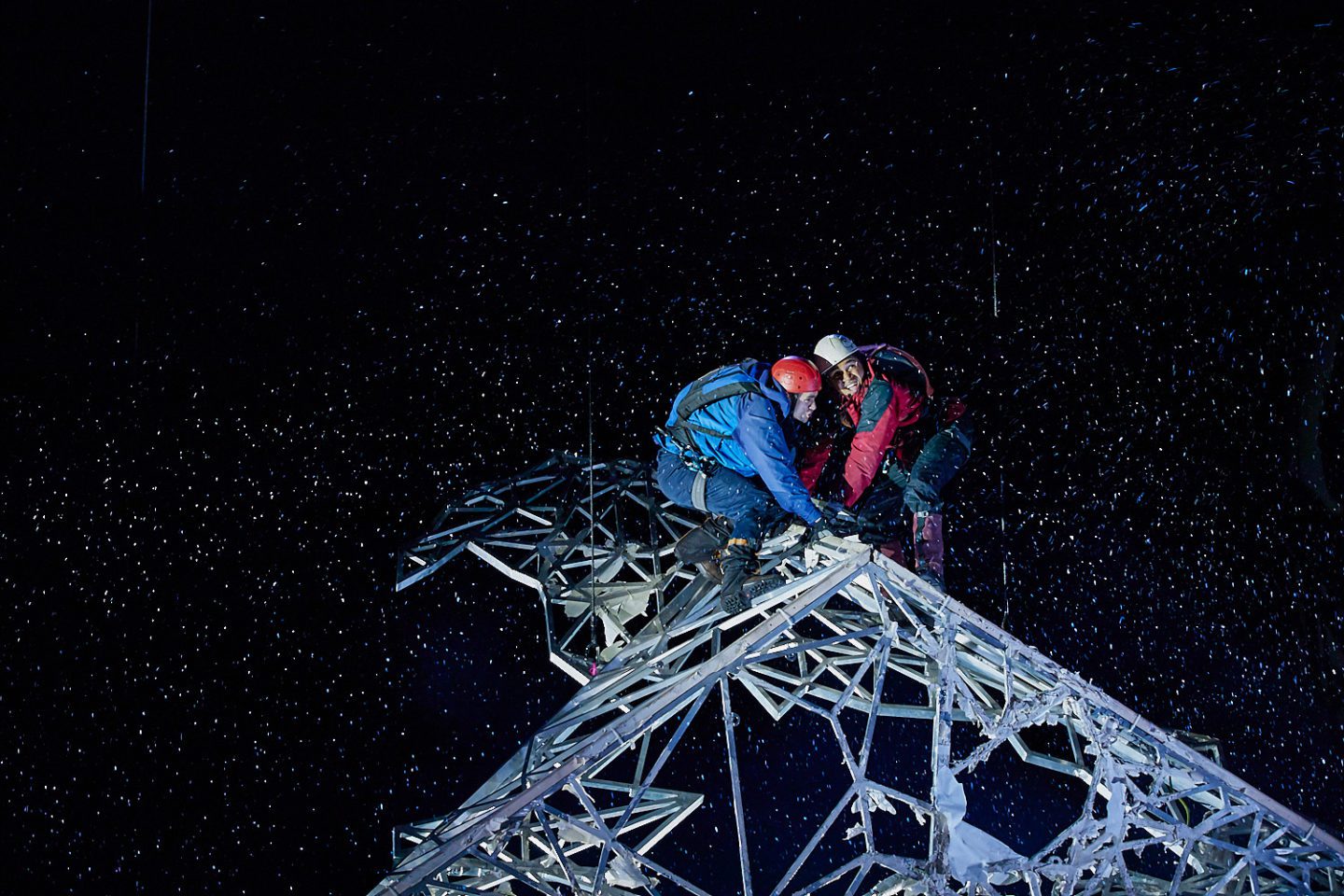'Did Joe survive because Joe was Joe, or did he survive because he was good at climbing?' asks writer David Greig. 'You can't really tease the two things out, but there is an element to which everyone's two sides of a sheet of paper. Sometimes the same quality that can feel like a burden in everyday life - some darkness, or depression, some sense of internal angst - can also be the thing that saves you once you're up against it. So Joe might say he did what any climber would have done. But it still feels right to ask, "What was specific to him?"'
Thirty-five years after climber Joe Simpson was given up for dead on the west face of the Siula Grande in the Peruvian Andes his story has lost none of its compulsion. The account – of how, against the odds, he survived more than three days on his own after plummeting into a crevasse with a broken leg during a storm – started out as an article for a climbing magazine before becoming a book whose six figure sum sales led it to be translated into twenty languages. The ensuing docudrama was described by one broadsheet critic as ‘the most successful documentary in British cinema history’.

Photography: Michael Wharley
In its most recent incarnation it has achieved the apparently impossible feat of bringing the mountain to the West End. Simpson himself has publicly stated that when he was first told that Touching the Void was being adapted for theatre, his reaction was ‘Good luck! How the hell are you going to stage that?’ In an initial conversation with writer David Greig and director Tom Morris, he told them straightforwardly that he didn’t want to be involved. ‘So if it succeeded, it was their success, and if it failed, it was their failure. A coward’s way out.’
Yet Greig and Morris both have form in putting the seemingly impossible on stage. Greig’s sparkily intelligent plays and adaptations have dealt with everything from cosmonauts to Caligula. Morris, currently artistic director of Bristol Old Vic, has a flair for theatrical experimentation that has over the years seen him act as producer and, essentially, midwife to Jerry Springer the Opera, as well as successfully co-directing War Horse.
They knew, from the start, that they could not compete with film in evoking the physical experience of Simpson and fellow-climber, Simon Yates, battling their way first up and then down the Siula Grande. Yet they were also well aware of how theatre, at its best, can tap powerfully into the kind of primal emotions evoked by a story in which, for both men, the dividing line between life and death became precariously thin.
It wasn't literally his grave, but he was stranded, and in some ways as far away from life as is possible.
David Greig
‘Tom identified that this is essentially a story about a man coming back from the grave,’ says Greig. ‘It’s incredibly profound, and makes all of us ask, if we were in Joe’s position, would we have the ability to turn round and climb back? It wasn’t literally his grave, but he was stranded, and in some ways as far away from life as is possible. It’s very difficult for anyone to say in that situation if they would have the inner capacity to carry on.’
It’s a bleak Friday morning in Britain, just hours before the clocks will toll the end of Britain’s membership of the EU. I’m sitting hunched over a speakerphone in London, while Greig is up in Scotland where he is Artistic Director of Edinburgh’s Royal Lyceum Theatre. I ask what the turning points were in translating the story from the hostile Andean mountainscape to the more psychological domain of the theatre.
‘The conundrum of Touching the Void is that we all know that the guy survives – because he wrote the book,’ Greig replies, ‘yet we still want the palms of people’s hands to be sweating as we tell his story. A breakthrough moment was when we decided that we’d throw a curveball into the audience by telling the story from the point of view of Joe’s funeral as he’s imagining it, which gives a stronger sense of what’s at stake. The second breakthrough was related to Joe writing that one of the things that kept him going was this voice in his head, that was telling him to go on and would lacerate him if he wasn’t going fast enough. Tom identified a section in one of Joe’s other books where he talks about his sister, Sarah, and how she used to boss and almost bully him. To both of us, making the voice in Joe’s head her voice seemed like something we could have fun with – as well as providing a solution to the question of how you animate a story in which the main character is alone for 50% of the time.’

Photography: Michael Wharley
The most devastating moment of Touching the Void is famously the point at which Joe’s climbing partner, Simon Yates, cuts the rope that is holding Joe up, so that they are not both dragged off the edge of the mountain. Yates has been vilified over the years for this decision, though the moment any proper context is provided it’s clear he was in an impossible situation. ‘I think the climbing world has always been more understanding,’ says Greig, ‘because climbers know what that kind of situation is. But in the broader world that story hits a nerve. Tom was interested in it being almost like an Ancient Greek story – such as where Achilles kills Hector. But for me the job of the play was to get the audience to understand how they would do what Simon did. I had to get them to think, “If I was in that situation that is exactly what I would have to do”.’
Greig has a longstanding fascination with mountains and climbing culture. Yet though he enjoys fell running and hill climbing, he wrily describes himself as an ‘armchair mountaineer, which basically means I became obsessed with reading mountain literature. I don’t like heights, which is very unhelpful.’ Just over ten years ago he helped create a theatre work about climbing for the Tramway in Glasgow, ‘which was good training for what I do with Touching the Void. What I remember most strongly though is a review from a climbing magazine, in fact I think it was a climbing fanzine, where they pointed out that the ice axe we’d used was a hill walking ice axe and not a climbing ice axe. It was such a rookie error, such a source of embarrassment if you’re a climber, that it actually took the air out of everything. So I told Tom Morris when we started that if we were going to do this play, we needed to do it in such a way that if a climber came then they would go, “Right. These guys know their stuff.”‘
There’s always a certain balancing act to be struck between demonstrating technical expertise and telling a compelling story. Greig himself agrees that, ‘The only way I can get people to sweat is if I use the power of theatre to make them imagine it.’ Part of the play is set in the Clachaig Inn, Glencoe – popular in the climbing community, and the setting for Joe’s imagined wake. ‘We start by using the techniques of Poor Theatre [as evolved by Polish director Jerzy Grotowski], in that we have a pub, and we use the things in the pub to become the way of telling the story of climbing a mountain. That was our way in. Then, once the audience is going, “OK. That’s the way they’re going to do it,” we go “Boom. Here’s a giant piece of scenery.”‘
The giant piece of scenery is an extraordinary piece of kinetic sculpture by the designer Ti Green that looks like a cross between the skeleton of a monstrous pterodactyl and a mountain peak designed by Escher. ‘We called the sculpture Doris,’ he says. ‘I can’t remember why. But Ti’s piece of genius was to use paper to cover the metal frame. It looks like snow – so somehow at the same time that it’s paper on metal, it’s also spindrift on rock. When the actors climb on it they crash through it, and it makes a noise like crunching through snow. It’s not a simulacrum of a mountain. It’s not how you’ve got a mountain in your head. When theatre design is at its best it becomes a perfect metaphor. You can absolutely see that it’s paper on metal. Yet somehow it perfectly sums up the reality.’

Photography: Michael Wharley
Does Greig think that – as much as being a story about a man coming back from the grave, it’s also about the degree to which all of us are tantalised by risk – whether it’s physical, emotional, or mental? He replies that for him it was important to convey that for many climbers the challenge is about more than risk. ‘In the play we had to explain these people don’t just climb – it’s their need, it’s their drive, it’s their body, it’s their soul. Though I was also very moved when I read about what it’s like to be a widow or partner of a climber who’s died, and the brutality of how you come to terms with the fact that in a sense they chose – not that there’s an element of choice exactly, but they put themselves in danger. I think if I were left in the position of a partner or relative I would be angry – it’s possible to understand both perspectives. For me the dynamic between Joe’s sister Sarah, saying, “What were you playing at you fucking idiot?” and Joe replying, “You don’t understand why I do this,” was the moment when the dialogue started to happen in the play.’
He found the most profound moment of writing the play to be the moment at which Sarah – as the voice in Joe’s head – is haranguing him about why he shouldn’t just give up and die. ‘That question – if you could slip gently away and it would be so much nicer just to let yourself go – why would you fight? So I had to try and put up an argument for life, and I had to give Sarah those words. For me it came down to the body. To touch, to smell, to what you hear – just simple factors.’
The play has been garlanded with five star reviews and has transferred from Bristol Old Vic to the Duke of York’s Theatre in the West End, where it will run until the end of this month. Has there been a significant difference to the way climbers and non-climbers have reacted to it? ‘The most bizarre thing I heard was somebody saying before the show, ‘Is this the one where the guy has to chew his own arm off? He’d created some amalgam of all the survival stories he’d heard. Other people have come out and said “Did he live?” And I’ll say, “Well, he wrote the book”.’ And in terms of those in the know? ‘Quite a lot of climbers are coming to the show – and they’re clearly telling their friends to come. My experience of climbers is that they’re notoriously looking for ways to save money. So I think if they’re willing to spend their hard earned cash coming to see a theatre show it means someone has told them it’s good.’
Touching the Void runs at the Duke of York’s Theatre till February 29. Click here for tickets










